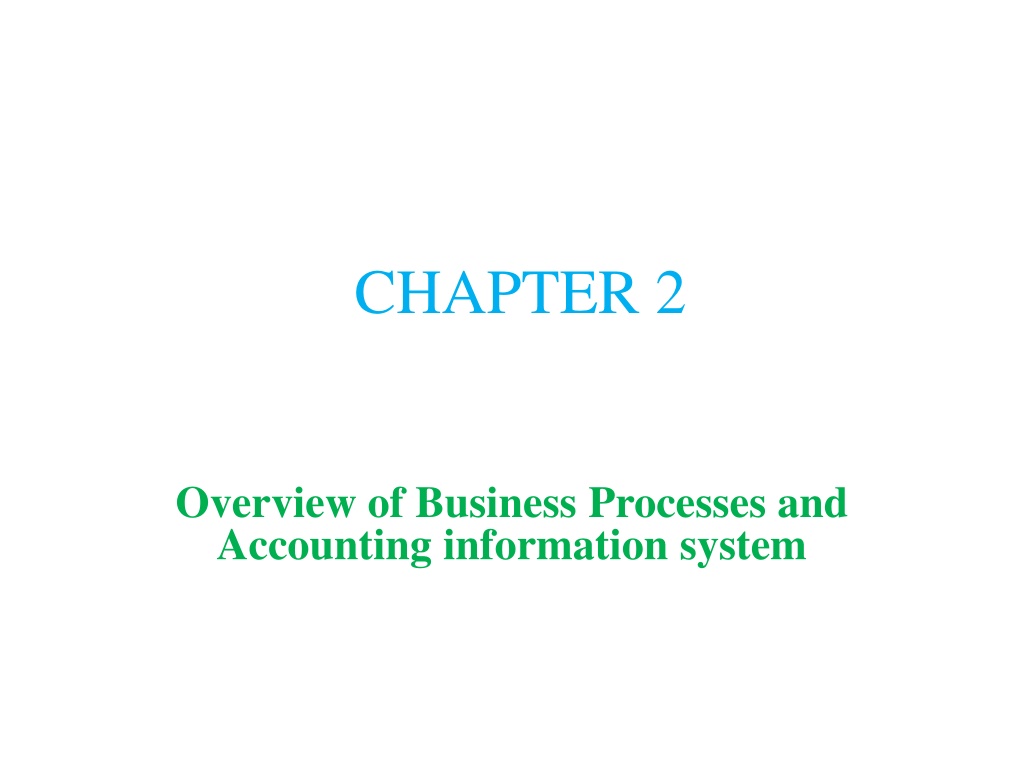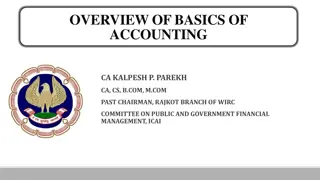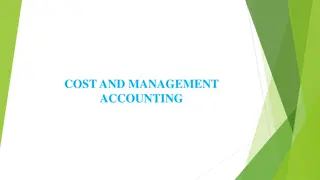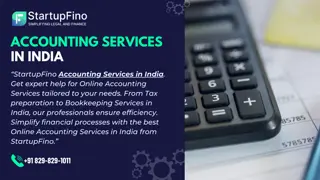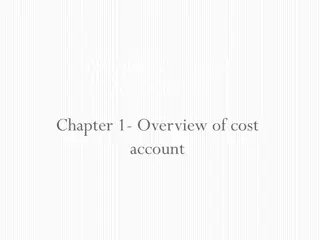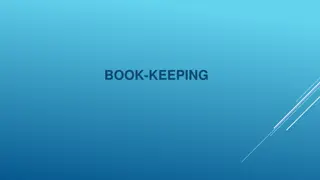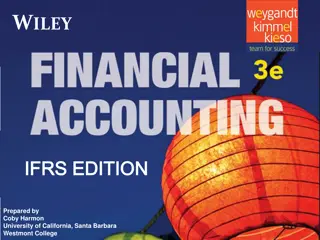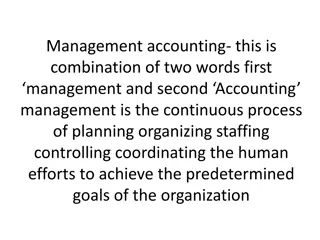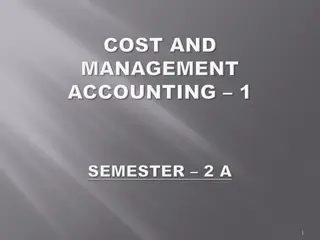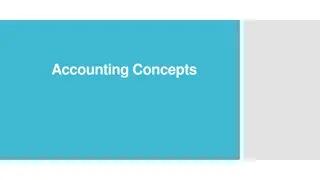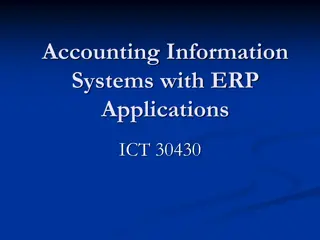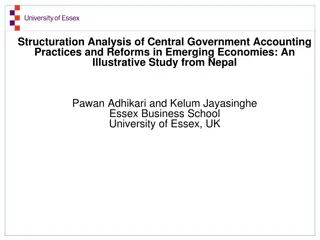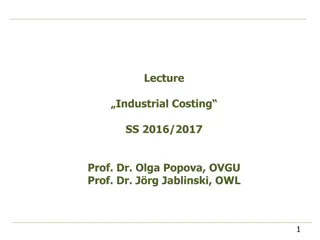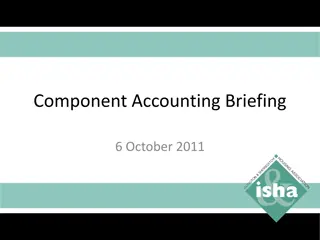Business Processes and Accounting Information Systems
This chapter provides an overview of essential business activities, decisions, and information required for organizational operations. It discusses the role of the data processing cycle in organizing activities and supplying information to users. Various types of information needed for decision-making are highlighted, including financial and non-financial data from internal and external sources. The interaction between AIS and external/internal parties is explored, emphasizing the importance of seamless information exchange.
Download Presentation

Please find below an Image/Link to download the presentation.
The content on the website is provided AS IS for your information and personal use only. It may not be sold, licensed, or shared on other websites without obtaining consent from the author. Download presentation by click this link. If you encounter any issues during the download, it is possible that the publisher has removed the file from their server.
E N D
Presentation Transcript
CHAPTER 2 Overview of Business Processes and Accounting information system
INTRODUCTION Questions to be addressed in this chapter include: o What are the basic business activities in which an organization engages? What decisions must be made to undertake these activities? What information is required to make those decisions? o What role does the data processing cycle play in organizing business activities and providing information to users
INFORMATION NEEDS AND BUSINESS ACTIVITIES Businesses engage in a variety of activities, including: Acquiring capital Buying buildings and equipment Hiring and training employees Purchasing inventory Doing advertising and marketing Selling goods or services Collecting payment from customers Paying employees Paying taxes Paying vendors Each activity requires different types of decisions
INFORMATION NEEDS AND BUSINESS ACTIVITIES Types of information needed for decisions: Some is financial Some is nonfinancial Some comes from internal sources Some comes from external sources An effective AIS needs to be able to integrate information of different types and from different sources.
INTERACTION WITH EXTERNAL AND INTERNAL PARTIES External Parties AIS The AIS interacts with external parties, such as customers, vendors, creditors, and governmental agencies.
INTERACTION WITH EXTERNAL AND INTERNAL PARTIES External Parties Internal Parties AIS The AIS also interacts with internal parties such as employees and management.
INTERACTION WITH EXTERNAL AND INTERNAL PARTIES External Parties Internal Parties AIS The interaction is typically two-way, in that the AIS sends information to and receives information from these parties.
BUSINESS CYCLES & AIS Many business activities are paired in give-get exchanges The basic exchanges can be grouped into five major transaction cycles(Which is considered as basic Subsystems in the AIS) Revenue cycle Expenditure cycle Production cycle Human resources/payroll cycle Financing cycle
BUSINESS CYCLES Many business activities are paired in give-get exchanges The basic exchanges can be grouped into five major transaction cycles. Revenue cycle Expenditure cycle Production cycle Human resources/payroll cycle Financing cycle
REVENUE CYCLE The revenue cycle involves interactions with your customers. You sell goods or services and get cash. Give Goods Get Cash
BUSINESS CYCLES Many business activities are paired in give-get exchanges The basic exchanges can be grouped into five major transaction cycles. Revenue cycle Expenditure cycle Production cycle Human resources/payroll cycle Financing cycle
EXPENDITURE CYCLE The expenditure cycle involves interactions with your suppliers. You buy goods or services and pay cash. Give Cash Get Goods and service
BUSINESS CYCLES Many business activities are paired in give-get exchanges The basic exchanges can be grouped into five major transaction cycles. Revenue cycle Expenditure cycle Production cycle Human resources/payroll cycle Financing cycle
PRODUCTION CYCLE In the production cycle, raw materials and labor are transformed into finished goods. Give Raw Materials & Labor Get Finished Goods
BUSINESS CYCLES Many business activities are paired in give-get exchanges The basic exchanges can be grouped into five major transaction cycles. Revenue cycle Expenditure cycle Production cycle Human resources/payroll cycle Financing cycle
HUMAN RESOURCES/ PAYROLL CYCLE The human resources cycle involves interactions with your employees. Employees are hired, trained, paid, evaluated, promoted, and terminated. Give Cash Get Labor
BUSINESS CYCLES Many business activities are paired in give-get exchanges The basic exchanges can be grouped into five major transaction cycles. Revenue cycle Expenditure cycle Production cycle Human resources/payroll cycle Financing cycle
FINANCING CYCLE The financing cycle involves interactions with investors and creditors. You raise capital (through stock or debt), repay the capital, and pay a return on it (interest or dividends). Give Cash Get cash
Business process and AIS Many business activities are paired in give-get exchanges The basic exchanges can be grouped into five major transaction cycles. Revenue cycle Expenditure cycle Production cycle Human resources/payroll cycle Financing cycle
BUSINESS CYCLES & AIS Thousands of transactions can occur within any of these cycles. But there are relatively few types of transactions in a cycle. EXAMPLE: In the revenue cycle, the basic give- get transaction is: Give goods or service Get cash
BUSINESS CYCLES Other transactions in the revenue cycle include: Handle customer inquiries Take customer orders Approve credit sales Check inventory availability Initiate back orders Pick and pack orders Ship goods Bill customers Note that the last activity in any cycle is to send information to other cycles. Update sales and Accts Rec. for sales Receive customer payments Update Accts Rec. for collections Handle sales returns, discounts, & bad debts Prepare management reports Send info to other cycles
BUSINESS CYCLES Generally, every transaction cycle: Relates to other cycles Interfaces with the general ledger and reporting system, which generates information for management and external parties.
Finished Goods Expenditure Cycle Revenue Cycle Production Cycle The revenue cycle Gets finished goods from the production cycle Provides funds to the financing cycle Provides data to the General Ledger and Reporting System General Ledger and Reporting System Human Res./ Payroll Cycle Financing Cycle
Raw Mats. Revenue Cycle Expenditure Cycle Production Cycle Data General Ledger and Reporting System The expenditure cycle Gets funds from the financing cycle Provides raw materials to the production cycle Provides data to the General Ledger and Reporting System Human Res./ Payroll Cycle Financing Cycle
Finished Goods Raw Mats. Expenditure Cycle Revenue Cycle Production Cycle General Ledger and Reporting System The production cycle: Gets raw materials from the expenditure cycle Gets labor from the HR/payroll cycle Provides finished goods to the revenue cycle Provides data to the General Ledger and Reporting System Human Res./ Payroll Cycle Financing Cycle
Revenue Cycle Expenditure Cycle Production Cycle General Ledger and Reporting System The HR/payroll cycle: Gets funds from the financing cycle Provides labor to the production cycle Provides data to the General Ledger and Reporting System Human Res./ Payroll Cycle Funds Financing Cycle
Expenditure Cycle Revenue Cycle Production Cycle General Ledger and Reporting System The Financing cycle: Gets funds from the revenue cycle Provides funds to the expenditure and HR/payroll cycles Provides data to the General Ledger and Reporting System Human Res./ Payroll Cycle Funds Financing Cycle
Expenditure Cycle Revenue Cycle Production Cycle Data Information for Internal & External Users General Ledger and Reporting System The General Ledger and Reporting System: Gets data from all of the cycles Provides information for internal and external users Data Human Res./ Payroll Cycle Financing Cycle
DATA PROCESSING CYCLE Accountants play an important role in data processing. They answer questions such as: What data should be entered and stored? Who should be able to access the data? How should the data be organized, updated, stored, accessed, and retrieved? How can scheduled and unanticipated information needs be met. To answer these questions, they must understand data processing concepts.
DATA PROCESSING CYCLE An important function of the AIS is to efficiently and effectively process the data about a company s transactions. In manual systems, data is entered into paper journals and ledgers. In computer-based systems, to convert data to information a series of operations performed on data is referred to as the data processing cycle.
DATA PROCESSING CYCLE The data processing cycle consists of four steps: Data input Data storage Data processing or process data to information Information output
THE DATA PROCESSING CYCLE The data processing cycle consists of four steps: Data input Data storage Data processing Information output
DATA INPUT The first step in data processing is to capture the data. Usually triggered by a business activity. Data is captured about: The event that occurred The resources affected by the event The agents who participated
DATA INPUT Historically, most businesses used paper source documents to collect data and then transferred that data into a computer. Today, most data are recorded directly through data entry screens. Control over data collection is improved by: pre-numbering each source document and using turnaround documents having the system automatically assign a sequential number to each new transaction
Common Source Documents and Functions E.G HUMAN RESOURCES and GENERAL LEDGER CYCLE Source Document Function Time cards Record time worked by employees. Job time tickets Record time spent on specific jobs. Journal voucher Record entry posted to general ledger.
DATA PROCESSING CYCLE The data processing cycle consists of four steps: Data input Data storage Data processing Information output
COMPUTER-BASED STORAGE CONCEPTS Now let s moving on to discussing some computer-based storage concepts, including: Entity Attribute Record Data Value Field File Master File Transaction File Database
COMPUTER-BASED STORAGE CONCEPTS An entity is something about which information is stored. In your university s student information system, one entity is the student. The student information system stores information about students. What are some other entities in your student information system?
COMPUTER-BASED STORAGE CONCEPTS Attributes are characteristics of interest with respect to the entity. Some attributes that a student information system typically stores about the student entity are: Student ID number Phone number Address What are some other attributes about students that a university might store?
COMPUTER-BASED STORAGE CONCEPTS A field is the physical space where an attribute is stored. The space where the student ID number is stored is the student ID field. IDNO Name Father name Seleshe Chane Ferera Phone number 0953721111 0957440236 0957475863 E/9099/05 E/90100/05 E/90101/5 Samson Abebe Fugge
COMPUTER-BASED STORAGE CONCEPTS A record is the set of attributes stored for a particular instance of an entity. The combination of attributes stored for Abebe Chine is Abebe s record. IDNO Name Father name Seleshe Chine Ferera Phone number 0953721111 0957440236 0957475863 E/9099/05 E/90100/05 E/90101/5 Samson Abebe Fugge
COMPUTER-BASED STORAGE CONCEPTS A data value is the intersection of the row and column. The data value for Abebe Chine s phone number is 095-744-0236. IDNO Name Father name Seleshe Chine Ferera Phone number 0953721111 0957440236 0957475863 E/9099/05 E/90100/05 E/90101/5 Samson Abebe Fugge
COMPUTER-BASED STORAGE CONCEPTS A file is a group of related records. The collection of records about all students at the university might be called the student file. If there were only three students and four attributes stored for each student, the file might appear as shown below: IDNO Name Father name Seleshe Chine Ferera Phone number 0953721111 0957440236 0957475863 E/9099/05 E/90100/05 E/90101/5 Samson Abebe Fugge
COMPUTER-BASED STORAGE CONCEPTS A master file is a file that stores cumulative information about an organization s entities. It is conceptually similar to a ledger in a manual AIS in that: The file is permanent The file exists across fiscal periods Changes are made to the file to reflect the effects of new transactions.
COMPUTER-BASED STORAGE CONCEPTS A transaction file is a file that contains records of individual transactions (events) that occur during a fiscal period. It is conceptually similar to a journal in a manual AIS in that: The files are temporary The files are usually maintained for one fiscal period
COMPUTER-BASED STORAGE CONCEPTS A database is a set of interrelated, centrally- coordinated files. When files about students are integrated with files about classes and files about instructors, we have a database. Data base Student File Class File Instructor File
DATA PROCESSING CYCLE The data processing cycle consists of four steps: Data input Data storage Data processing Information output
DATA PROCESSING Once data about a business activity has been collected and entered into a system, it must be processed.
DATA PROCESSING There are four different types of file processing: Updating data to record the occurrence of an event, the resources affected by the event, and the agents who participated, e.g., recording a sale to a customer. Changing data, e.g., a customer address Adding data, e.g., a new customer. Deleting data, e.g., removing an old customer that has not purchased anything in 5 years.
DATA PROCESSING Updating can be done through several approaches: Batch processing
